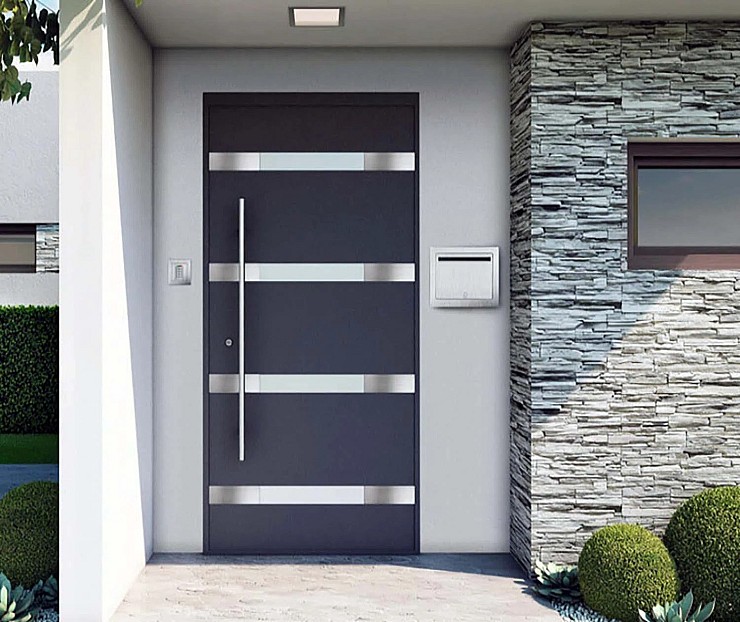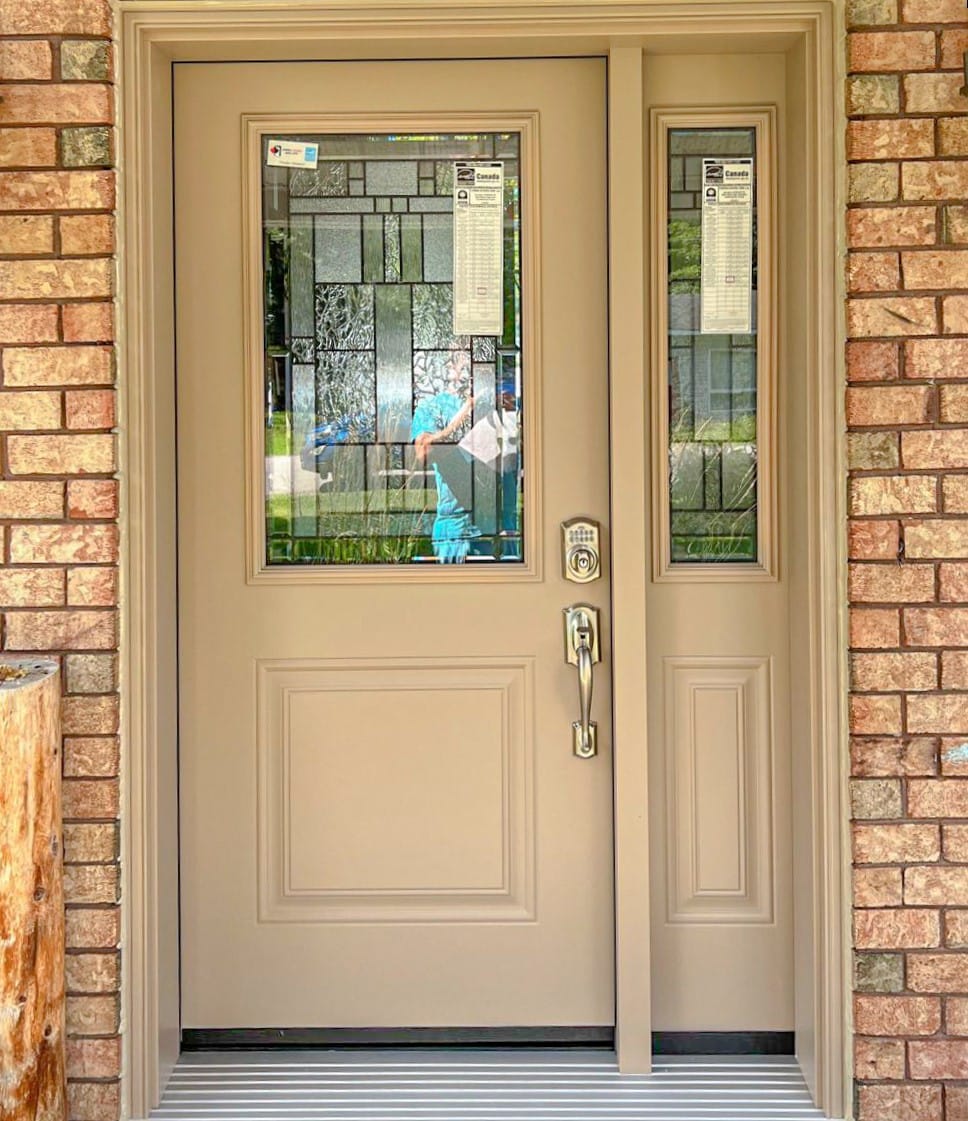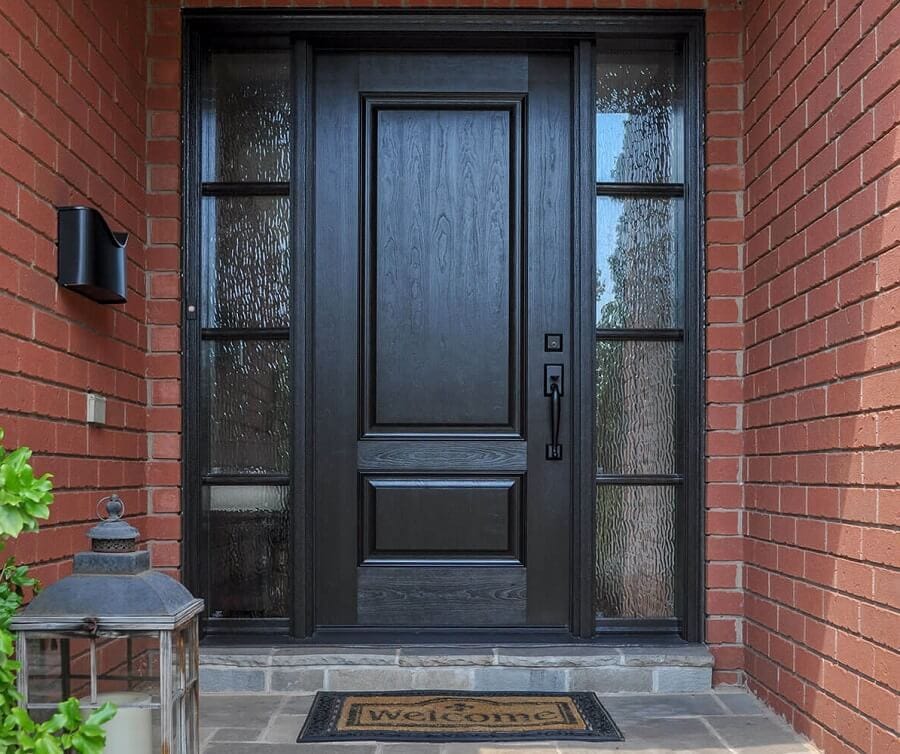What Makes an Entry Door Energy Efficient

When people think about saving energy at home, they often focus on windows or insulation. But your entry door plays a much bigger role than you might expect. As someone who works with doors every day, I can tell you that good front doors can make your home more comfortable and your energy bills lower.
Most homeowners I speak with are surprised to learn how much heat escapes through poorly sealed or outdated doors. In winter, that means your furnace has to work harder. In summer, your air conditioner runs longer. That’s wasted energy. And wasted money.
In this post, I’ll walk you through what actually makes an entry door energy efficient. I’ll explain what to look for, what to avoid, and how proper installation makes all the difference.
Let’s start with the basics.
Why Your Entry Door Affects Energy Use

Your front door is more than just a way in and out. It’s part of your home’s exterior envelope. If that envelope leaks, energy slips right through.
Older doors, especially wood ones, tend to warp or shrink over time. That creates small gaps where cold air can get in. Even a tiny draft around the edges can make a big difference in your comfort and utility bills.
Newer, well-designed doors are built to seal tightly. The materials are also better at resisting heat and cold. Together, these features help keep your indoor air inside.
Now, let’s break down what to look for.
The Core of the Door Matters
The inside of the door is just as important as the outside.
Most energy-efficient doors have a solid, insulated core. This is usually made of polyurethane foam. It helps block the transfer of heat or cold from one side of the door to the other.
If your door sounds hollow when you knock on it, chances are it’s not insulated. That means it's letting in outdoor temperatures, which forces your heating and cooling system to work harder.
I always recommend looking for a door with a high insulation value. If you're comparing options, check the R-value. The higher the number, the better the insulation.
Not All Materials Perform the Same
Different materials insulate in different ways. Some are better at keeping energy inside your home.
Here’s a quick breakdown:
Fiberglass

This is one of the best options for energy efficiency. Fiberglass doors are lightweight but strong. They don’t warp or shrink like wood. And they often come with a foam core built in. They also handle extreme temperatures well.
Steel
Steel doors are very durable and secure. Many also have insulated cores. However, steel can transfer heat or cold more easily than fiberglass unless it includes thermal breaks.
Wood
Wood doors look beautiful, but they’re not the best choice for energy efficiency. Wood expands and contracts with the seasons. Over time, that can lead to small gaps. Some higher-end wood doors are built with insulation layers inside, but they’re more expensive.
If energy efficiency is your top priority, I suggest going with fiberglass or insulated steel.
Weatherstripping Is Not Optional
Even the best door will leak air if it doesn’t seal properly. That’s where weatherstripping comes in.
Good weatherstripping runs along the edges of the door. It compresses when the door closes and blocks air movement. It also helps keep out water and dust.
Over time, weatherstripping can wear down. It can crack or flatten. If you feel a draft around your door, this is one of the first things I would check.
I’ve seen many homes where the door itself was fine, but the weatherstripping was failing. Replacing it can make a huge difference, and it doesn’t cost much.
Look for Tight Seals Around the Frame
The frame around the door matters too. It needs to be square and tight. A poor fit means gaps. Gaps mean drafts.
A common issue I see is settling in older homes. This causes the door to hang slightly off level. When that happens, the seal is broken in some places, even if the weatherstripping looks fine.
That’s why I always stress the importance of professional installation. A properly installed door fits flush with the frame. It doesn’t rattle. And it closes with a clean, even seal on all sides.
Glass Panels Can Be a Weak Spot
Many entry doors include glass panels. They look great, and they let in light. But they can also let in heat or cold if not designed properly.
If you want glass in your door, choose energy-efficient options. Look for:
- Double or triple glazed glass
- Low-E coatings that reflect heat
- Gas-filled panes (usually argon or krypton)
These features reduce heat loss while still letting in natural light. Some decorative glass panels are not insulated at all. Those should be avoided if energy use is a concern.
Multi-Point Locking Improves Efficiency
Energy efficiency is also about how tightly the door closes. A multi-point lock pulls the door tight at several points. This creates a stronger seal than a single lock can.
In winter, this prevents cold air from sneaking in along the edge of the door. It also improves security, which is a nice bonus.
Most high-quality entry doors now come with this feature, and I recommend choosing one that does.
Always Check for Energy Star Certification
If you want a shortcut to identifying an energy-efficient door, look for the Energy Star label.
This label means the door has been tested and meets strict standards for energy performance. In Canada, Energy Star doors are rated for our colder climate. That gives you peace of mind that the door performs the way it should.
Not every good door has this label, but most of the best ones do.
Why Installation Is Just as Important as the Door
Even the most efficient door can fail if it’s installed poorly. I’ve seen it too many times.
A rushed or careless installation can leave gaps between the frame and the wall. Or the door might not close properly. These problems lead to drafts, leaks, and wasted energy.
At Delco, we take our time with every install. We measure carefully. We level and square everything. We also insulate around the frame to make sure no heat escapes. That’s something not all installers do, but it makes a real difference.
If you’re investing in a good door, don’t cut corners on installation. You’ll lose the benefits if it’s done wrong.
The Long-Term Benefits
An energy-efficient entry door does more than just lower your bills.
It helps keep your home more comfortable all year long. Rooms near the front of the house stay warmer in winter and cooler in summer. Outside noise is reduced. Moisture stays out. And your HVAC system runs less, which extends its life.
Over time, you’ll notice a difference not just in your energy use, but in how your home feels.
What I Recommend
If you’re shopping for a new entry door, here’s my advice:
- Choose a fiberglass or insulated steel door
- Make sure it has a foam-filled core
- Look for Low-E glass if there are glass inserts
- Confirm that it seals tightly and includes good weatherstripping
- Ask for Energy Star certification
- Always hire a professional for the installation
At Delco, we help homeowners across Toronto choose doors that look great and perform even better. We understand our climate. And we know how to install a door that will stand up to it for years.
Final Thoughts
A lot of people underestimate the role their front door plays in home efficiency. But the truth is, a poorly performing door can undo the benefits of your insulation and windows.
If your current door is drafty, cold to the touch, or lets in noise, it may be time for an upgrade.
So if your door is old, drafty, or just not doing its job, it might be time for a change.
And if you’re not sure where to start, we’re here to help. At Delco, we take the time to make sure every door fits right, seals tight, and performs the way it should. Get in touch with our team today.











